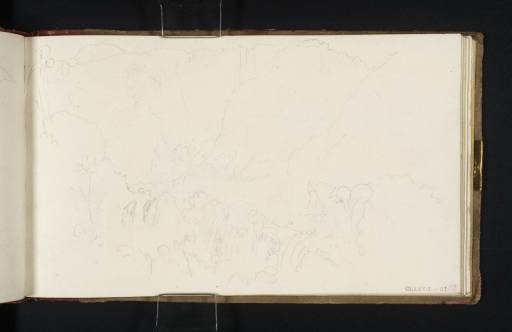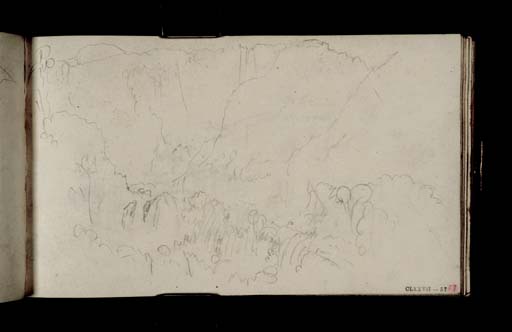Joseph Mallord William Turner Cascata delle Marmore from the Belvedere Inferiore 1819
Image 1 of 2
Joseph Mallord William Turner,
Cascata delle Marmore from the Belvedere Inferiore
1819
Joseph Mallord William Turner 1775–1851
Folio 57 Recto:
Cascata delle Marmore from the Belvedere Inferiore 1819
D14763
Turner Bequest CLXXVII 57
Turner Bequest CLXXVII 57
Pencil on white wove paper, 110 x 186 mm
Inscribed by John Ruskin in red ink ‘57’ bottom right
Stamped in black ‘CLXXVII 57’ bottom right
Inscribed by John Ruskin in red ink ‘57’ bottom right
Stamped in black ‘CLXXVII 57’ bottom right
Accepted by the nation as part of the Turner Bequest 1856
References
1909
A.J. Finberg, A Complete Inventory of the Drawings of the Turner Bequest, London 1909, vol.I, p.522, as ‘Do. [Cascade of Terni.]’.
1984
Cecilia Powell, ‘Turner on Classic Ground: His Visits to Central and Southern Italy and Related Paintings and Drawings’, unpublished Ph.D thesis, Courtauld Institute of Art, University of London 1984, pp. 101, 469 note 143, 103 note 150.
1987
Cecilia Powell, Turner in the South: Rome, Naples, Florence, New Haven and London 1987, p.34.
2008
James Hamilton, Nicola Moorby, Christopher Baker and others, Turner e l’Italia, exhibition catalogue, Palazzo dei Diamanti, Ferrara 2008, pp.44, 90 note 29.
2009
James Hamilton, Nicola Moorby, Christopher Baker and others, Turner & Italy, exhibition catalogue, National Galleries of Scotland, Edinburgh 2009, pp.42, 150–1 note 29.
At the Umbrian town of Terni Turner made a short detour from the direct road to Rome in order to visit the famous waterfall, approximately three miles to the east. An entirely man-made phenomenon, the Falls of Terni were created by the ancient Romans who diverted the River Velino to descend into the Nera valley beneath in three successive stages. The whiteness of the waters led to the popular appellation of the ‘Cascata’ or ‘Caduta delle Marmore’ (Falls of Marble). During the eighteenth and nineteenth centuries the site represented one of the most popular tourist destinations in Italy outside of Rome and the Papal Government exercised a monopoly on guides and vehicle hire so that unless travellers were prepared to walk the distance from Terni, they were obliged to pay to access the site.1 In 1781, Pope Pius VI ordered the construction of two viewing huts to accommodate the increasing numbers of visitors. One of these shelters, the Belvedere Inferiore, allowed a vista of the entire spectacle from the bottom of the falls, whilst the other, the Belvedere Superiore, was situated on a projecting spur of rock, almost level with the brink of the summit.
This sketch depicts the Cascata delle Marmore, with its three distinct levels from below, at the Belvedere Inferiore. For a similar view, and a full discussion see folio 55 verso (D14760).
Nicola Moorby
November 2008
Benjamin Colbert, Shelley’s Eye: Travel Writing and Aesthetic Vision, London 2005, pp.161–2. Today the site is still a popular visitor attraction. Most of the time however, the majority of the water is diverted for use in a hydroelectric power plant and the falls are only ‘turned on’ intermittently for the benefit of tourists, see http://www.marmore.it/document.php?id=14 , accessed November 2008.
How to cite
Nicola Moorby, ‘Cascata delle Marmore from the Belvedere Inferiore 1819 by Joseph Mallord William Turner’, catalogue entry, November 2008, in David Blayney Brown (ed.), J.M.W. Turner: Sketchbooks, Drawings and Watercolours, Tate Research Publication, December 2012, https://www


